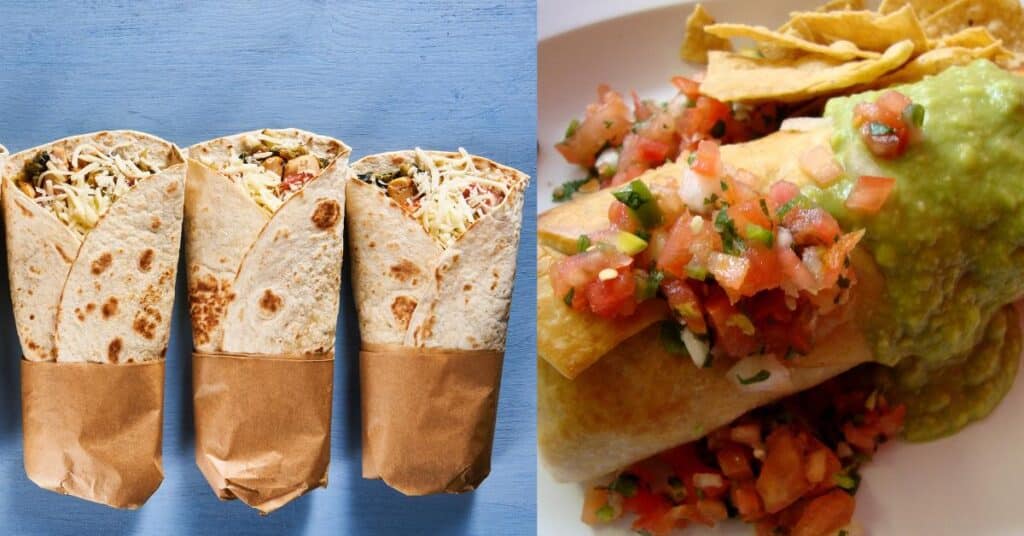
Diving into the world of Tex-Mex cuisine, you might find yourself caught in a delicious dilemma: the age-old debate of chimichanga vs burrito. In this post, we’ll explore the similarities and differences between chimichangas and burritos.
Chimichanga vs. Burrito: What’s the Difference?
Ingredients
Chimichangas are flour tortillas filled with rice, beans, cheese, and meat, rolled with closed ends, or wrapped into a rectangular shape and fried. Burritos are flour tortillas folded over the filling with closed ends. Burritos are not fried, leaving them with a softer texture.
Fillings
The chimichanga and burrito both have a flour tortilla as the outer shell, enveloping their various fillings. They also share similar fillings, which are:
- Meat (such as beef, chicken, or pork)
- Beans (either refried or whole)
- Rice
- Cheese
However, you might encounter a few differences in the specific types of ingredients each dish may include. For instance, burritos could feature cold ingredients like guacamole, sour cream, or salsa, which chimichangas typically don’t have inside their tortilla.
Cooking Methods
Chimichangas are deep-fried, and burritos are not. This results in a crispy, golden exterior for chimichangas, contrasting with the soft, tender texture of burritos.
Origins and Cultural Significance
Tex-Mex Cuisine
The chimichanga and burrito share common roots in Tex-Mex cuisine, a hybrid of Mexican and American food. The origin of the chimichanga is often traced back to Arizona, where Woody Johnson, founder of the Mexican restaurant chain Macayo’s Mexican Kitchen, claimed to have invented it in 1946 by deep frying a burrito.
Northern Mexico
Another theory about the origin of the chimichanga brings us to Northern Mexico, particularly the states of Sonora and Chihuahua. This story tells of Chinese immigrants who settled in Sonora in the early 1900s, possibly introducing the concept of deep frying, resembling an egg roll, to Mexican cuisine.
The burrito is from the northern Mexican region. It became popular not only for its delicious taste but this handheld meal made it easy for workers and farmers to bring their lunch to work.
Cooking Techniques
Deep Frying
Deep frying is the standard method for cooking a chimichanga. You’ll start by wrapping your burrito tightly, securing it with a toothpick to ensure that the filling stays intact. Then, gently lower the burrito into a deep fryer or a deep, heavy pan filled with hot oil. Ensure your oil reaches a temperature of around 350°F (175°C) for the perfect crispy outside. Exercise caution while frying, and cook each side for about 2-3 minutes until golden brown. Don’t forget to remove the toothpick before serving.
Baking
If you prefer lighter food, baking your chimichanga or burrito is an excellent alternative to deep frying. Preheat your oven to 400°F (200°C) and bake your chimichanga or burrito for 20-30 minutes until it’s crispy on the outside and warm on the inside.
Pan-Frying
Pan-frying offers another alternative to deep frying while still getting that crispy texture with less oil. Warm a tablespoon or two of oil in a non-stick skillet over medium heat. Place your rolled tortilla in the pan, seam-side down, and cook for 3-4 minutes on each side or until both sides are nicely browned and crispy.
Chimichanga vs. Burrito FAQs
What’s the main difference between chimichangas and burritos?
The main difference between chimichangas and burritos is the preparation. Burritos are served wrapped in a large flour tortilla with the ends open and can be eaten with your hands. On the other hand, chimichangas share similar ingredients, but they are deep-fried, giving them a crispy texture.
How does a chimichanga differ from an enchilada?
Chimichangas and enchiladas both have similar fillings, like meat and cheese, but their preparation is different. Chimichangas are deep-fried, while enchiladas are baked and covered in sauce. Enchiladas are also made with corn tortillas instead of flour tortillas, which are used in chimichangas.
What are some of the differences between burritos, enchiladas, and fajitas?
Burritos, enchiladas, and fajitas all have their differences in terms of ingredients and preparation. Burritos are made with flour tortillas and are usually eaten with your hands. Enchiladas are baked, saucy, and made with corn tortillas. Fajitas, on the other hand, consist of grilled meat and vegetables served with tortillas on the side.
What are some popular fillings for chimichangas and burritos?
Popular fillings for both chimichangas and burritos include rice, beans, cheese, and various types of meat like carne asada, barbacoa, carnitas, and chicken. The beans used can be black, pinto, or refried.

